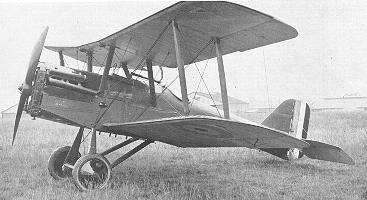S. E. 5a
 The
S.E.5/5a, rival of the Sopwith "Camel" for the title of
the most successful British fighter of the First World War, was designed by H. P. Folland,
J. Kenworthy and Major F. W. Goodden of the Royal Aircraft Factory. Stable and very
effective at high altitude, it made even a mediocre pilot look good. Though not as
maneuverable as the Camel or the Fokker DR.1 Triplane, it could
outdive anything the Germans flew.
The
S.E.5/5a, rival of the Sopwith "Camel" for the title of
the most successful British fighter of the First World War, was designed by H. P. Folland,
J. Kenworthy and Major F. W. Goodden of the Royal Aircraft Factory. Stable and very
effective at high altitude, it made even a mediocre pilot look good. Though not as
maneuverable as the Camel or the Fokker DR.1 Triplane, it could
outdive anything the Germans flew.
The prototype S.E.5, A4561, appeared in December 1916; it had the new
150 h.p. Hispano-Suiza engine with a car-type radiator and short exhaust manifolds. The
wings had wire-braced spruce spars; in place of compression struts, some ribs were of
solid construction. The tail-plane incidence could be changed in flight. A wire-braced
wooden box girder, the fuselage was fabric-covered except for plywood sides from the nose
to the front spar of the lower wing, with plywood round the cockpit. The main fuel tank
was behind the engine, and there was a gravity tank to port of the center section.
In January 1917 the wings of the prototype collapsed in flight, and
Major Goodden was killed. The main planes of subsequent machines were strengthened, their
span was reduced and blunter tips were fitted. A few of the early production aircraft,
however, retained the wing plan of the first two prototypes.
A Vickers gun fixed on the port side of the fuselage with its breech
inside the cockpit, fired through the air screw by means of the Constantinesco
synchronizing gear. A Lewis gun on a Foster mounting could be fired ahead over the top
wing or directly upwards.
The type first went to France on April 7th, 1917, with No. 56 Squadron.
The early machines had celluloid 'greenhouses' over the cockpits; these were liable to be
dangerous in a crash, so Major Blomfield, the C.O., had them replaced by flat Triplex
windscreens. The gravity tank was soon moved from the top of the wing to a position inside
the center section. A few S.E.5s had faired head-rests.
A modified version, the S.E.5a, powered by the 200 h.p. geared
Hispano-Suiza engine, was introduced in June 1917. It had a rather deeper nose than that
of the S.E.5, radiator shutters and long exhaust pipes. The standard faired head-rest was
frequently removed to improve the rearward view. From December 1917, the front struts of
the undercarriage vees were strengthened.
The geared 200 h.p. engine suffered from manufacturing faults, and there
were frequent failures; in addition, engine construction lagged behind airframe
manufacture, and the S.E.5a was not available in quantity until well into 1918. Eventually
the Wolseley W.4a Viper 200 h.p. engine, based on the Hispano-Suiza, became standard and
there were no more engine difficulties. The Viper's radiator was square and bulky, with
short horizontal shutters.
Both friend and foe recognized the S.E. as a formidable fighting
machine; it was fast, extremely strong and easy to fly. Superior to the Albatross D-III
and D-V, the Pfalz D-III and the Fokker Dr-I, it was not outclassed when the excellent
Fokker D-VII appeared in May 1918. It is significant that the S.E.5a was the mount of
Mannock (seventy-three victories), Bishop (seventy-two), McCudden (fifty-seven) and
Beauchamp-Proctor (fifty-four).
Some machines of No: 24 Squadron were rigged with reduced dihedral to
improve their maneuverability.

SPECIFICATIONS
Country: Great Britain
Manufacturer:
Designation: S. E. 5a
Service date: April 7, 1917
Wingspan: 27' 7"
Length: 20' 11"
Production: 5, 205
Armament
1 Vickers machine gun and 1 Lewis gun
PERFORMANCE
Engine: Wolseley W.4a Viper in-line 200 h.p.
Climb rate: 8 min. to 6,500 ft.
Ceiling: 19,500 ft
Max speed: 138 mph
U. S. Fighter Home Page | 'Aces' Home Page | Feedback
 The
S.E.5/5a, rival of the Sopwith "Camel" for the title of
the most successful British fighter of the First World War, was designed by H. P. Folland,
J. Kenworthy and Major F. W. Goodden of the Royal Aircraft Factory. Stable and very
effective at high altitude, it made even a mediocre pilot look good. Though not as
maneuverable as the Camel or the Fokker DR.1 Triplane, it could
outdive anything the Germans flew.
The
S.E.5/5a, rival of the Sopwith "Camel" for the title of
the most successful British fighter of the First World War, was designed by H. P. Folland,
J. Kenworthy and Major F. W. Goodden of the Royal Aircraft Factory. Stable and very
effective at high altitude, it made even a mediocre pilot look good. Though not as
maneuverable as the Camel or the Fokker DR.1 Triplane, it could
outdive anything the Germans flew.